The Chiloé archipelago, in southwestern Chile, consists of 40 small islands, 36 of which are inhabited, and lies off the coast of the Los Lagos Region. The main island, Isla Grande Chiloé, is as big as Corsica and separated from the mainland by the Chacao Strait. It is accessible by ferry and 118 miles from north to south and about 40 miles wide. Leaving the mainland aboard the ferry, a gentle sea breeze carrying pure, salty air accompanies us on the half-hour crossing… Chiloé owes its name to the Huilliche-Mapuche word “chillwe” meaning “land of seagulls“. The Panamerican highway begins or ends – as the philosopher Spinoza said “it a depends on the point of view”- on Grande Chiloé and is the island only paved road. As you drive west, this road reveals stunning scenery. You pass fields, meadows, and groves (facing the mainland) and almost tropical forest before finally confronting the frightening and powerful Pacific Ocean along rugged shoreline featuring deep cliffs carved by thousands of years of erosion. The rest of the island has only dirt roads… The island has retained a distinct identity because of its physical isolation from the mainland and racial mixing between Spanish and natives. Fishing villages developed during the course of history on the eastern side where they are less exposed to ocean storms. Chilotan architecture reflects its unique culture… in part because of its physical isolation, but because of the building materials available, predominantly wood. Evangelized by Jesuits and then by the Franciscans, the natives, utilizing techniques from boat-building, created remarkable wooden churches. They were often built on sites dedicated to ancient local spiritual practices… Today we can still admire these churches dating from the 17th and 18th centuries. Very often, their facades are covered with Patagonian cypress wood tiles (alerce) in several forms, delicately worked and assembled. As for the roofs, they are made of wooden shingles! An example is the magnificent church of Dalcahue, one of the sixteen churches on Chiloé declared UNESCO World Heritage Sites in 2000.
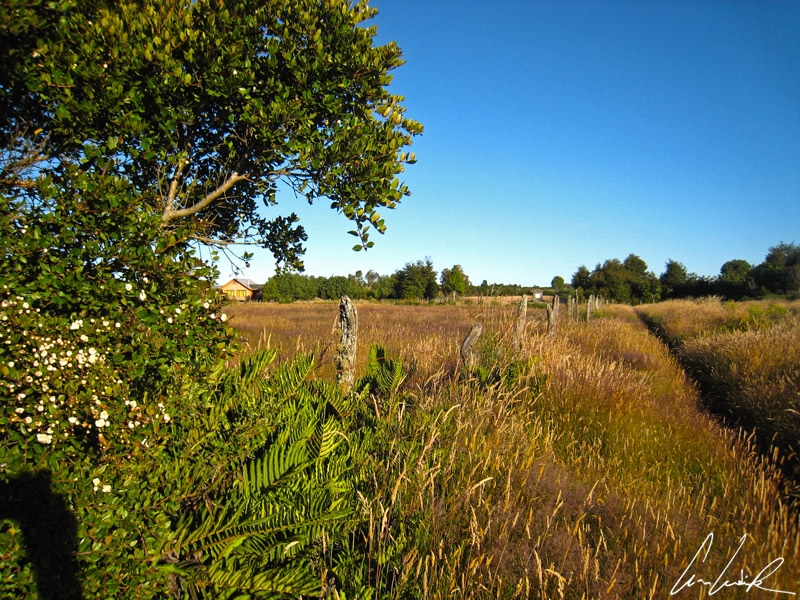
Meadows and groves
Chilote architecture withstands well the wet and humid climate of the archipelago. The western side of Chiloé Island has no dry season. Annual precipitation is about 79 inches and the average annual temperature 48 °F. Churches are often near the coastline, but usually built on the hillside to prevent flooding during the heavy rains between May and August and also to be seen by sailors. The north side of the church carries extra protection from storms, which usually come from this direction. Sixty churches in the archipelago correspond to the so-called Chilota School of wooden religious architecture. Sixteen of them, the most representative, are classified as national monuments and were designated UNESCO World Heritage sites in 2000. They are located in the municipalities of Castro, Chonchi, Dalcahue, Puqueldón, Quemchi, and Quinchao. The UNESCO declaration says, “These churches embody the intangible richness of the Chiloé Archipelago, and bear witness to a successful fusion of indigenous and European culture, the full integration of its architecture in the landscape and environment, as well as the spiritual values of the communities“. Whether the Church of St. Francis de Castro designed by Italian architect Eduardo Provasoli with neo-gothic arrows painted in yellow, rose and aubergine or the beautiful blue and white church of Our Lady of Patrocinio (Iglesia Nuestra Señora del Patrocinio) located in the fishing village of Tenaún, each Catholic church on Chiloé has a charm of its own. Their size is determined by the importance of the religious celebrations that took place there. And yet despite their “great age,” these churches have preserved their authenticity. They always serve as places of worship and are carefully maintained by the communities.

Church of Dalcahue
Tenaún, a small village on Isla Grande Chiloé, is located about 55 miles from the capital Castro and characterized by the style of its houses, especially that of the magnificent blue colored church Nuestra Señora del Patrocinio dating from 1842. In the Huilliche-Mapuche language Tenaún means “three hills.” This large church has a design unique to the island: a pointed roof and three towers, a large central one and two smaller ones at the sides of the main facade. The three towers might refer the “Three Hills” of Tenaún. The central, dominant tower is topped with a cross used by sailors as an orientation point. All three towers are octagonal, to reduce their resistance to wind. The portico includes colonnades and arches. Since the village is very small and few tourists venture there, we asked an “abuelita” (an old woman) to open the door of the church, “Ouvre-moi la porte toi qui as la clef / De la grande école du monde / Ce n´est pas facile de te faire entrer / Mais je vais quand même essayer… ” (Ouvre moi la porte by the French singer Enrico Macias) translated as “You with the key, open the door / Of the big school of the world / It is not easy to make you enter / But I am still going to try… ” Longer than wide, the church has a basilica layout with three naves separated by solid wooden columns resting on blocks of stone. The central nave is surmounted by a barrel vault ceiling resembling an inverted ship and the aisles have flat ceilings. The attempt to bring Christianity into pagan lands resulted in a mingling of traditional beliefs, still alive, and Catholicism. The resultant cosmogony explains the birth and life of the islands, temptations of the people, and societal taboos… We often find representations of chilote mythology inside the churches: a mythical ghost ship from local folklore (el Caleuche – doesn’t that remind you of an episodes from the 2003 series “Pirates of the Caribbean”?), a siren, a poetic vision of a fisherman’s love for the beauty of the sea (Pincoya), gnomes (el Trauco), wizards (brujos)… In Chiloé, Catholicism is closely linked to traditional beliefs! Thus people rush to baptize their first-born son so that he is not transformed into Invunche,the monstrous and dangerous guard of the grotto brujo …

The sloped roof covered with wooden shingles
Most of the year the island of Chiloé is covered by mist or low gray clouds. As soon as sunbeams pierce the mists, Chiloé unveils impressive landscapes. Its old wooden churches, its fishing boats, its hills and groves and especially its houses multicolored wood shingle houses are suddenly revealed in a way we hadn’t seen before. The houses of Chiloé tell a story in wood, color, shingles, and transience. What do I mean by “transience” ? Simply that the first buildings on the island were small houses that could be moved according to economic need and family changes. The houses were set on large round stones (the size of a big pumpkin), partially embedded in the ground to shield the house from moisture. This technique also had the advantage that the house was not tied to the ground. Even today, we sometimes see a cart wheel (about 1 meter in diameter) placed at a corner of a house to remind us of this itinerant past… These houses were made of wood, and they have survived for the most part. The facades are covered with wooden shingles in different shapes, finely worked and carefully assembled. The sloped roof that was once covered thatched in the Mapuche style and later covered with wooden shingles, unfortunately, tends to be replaced by galvanized corrugated sheets. Nowadays, chilots still build wooden houses using the ancestral traditions. The house is no longer placed on large stones, but is built on a fixed foundation. On the other hand, the technique for the frame remains the same. Each house consists of a wooden structure forming the main skeleton, including the joists of the floors, external walls, and the partitions. The presence of vast forests on the island of Chiloé has encouraged the supremacy of wood and its unique culture, for houses, shipbuilding, and furniture. At present, Nothofagus, also know as Lenga beech (related to European oaks and chestnut trees), has replaced alerce or Patagonian cypress (Fitzroya Cupressoides.) Because of deforestation, the alerce is now protected. Nothofagus has good-quality wood. The trunk is long and the wood without knots, easy to work with and resistant to pests, all characteristics making it good for building and carpentry. The trees can be 100 feet tall with a diameter up to 5 feet. The Chilote tradition to paint their houses with bright colors so as to brighten their surroundings under the often gloomy sky.

Pacific Ocean
Chiloé seduces. It is difficult to resist its picturesque charm, its colorful houses, its vast expanses of nature… and its ocean filled with fishermen’s history. The fishing industry is very important to the island’s economy and has defined the life and culture of the Island. The island is known the “Buzos” (divers) who dive as deep as 130 feet into the water to harvest sea urchins, clams and seaweed, but today fishermen with their small wooden boats face economic challenges for survival, as well as a scarcity of fish. The Chilean administration wants to professionalize the fishery by requiring fishermen to have a license to fish… Although the fishermen know the ocean better than anyone else, their level of education makes it hard to obtain a license, and they cannot fish ! In addition to a license, fishermen will soon be required to carry life insurance… In other words, no one will give these men the documents they need to work to exhaustion. Also, as if this wasn’t enough, the industrial fishing industry waits in the wings threatening local fishermen on the island. A sad reality, this should not prevent you from enjoying a delicious “Curanto“, the traditional dish of Chiloé. It consists of a delicious mix of seafood, meat, and vegetables. Its preparation is a real party involving the whole community! First they dig a hole about 20 inches deep and cover with large hot stones heated in a bonfire. Over the stones they arrange a variety of “mariscos” (shellfish) including “cholgas” (ribbed mussels), “almejas” (clams), “choritos” (small mussels), picorocos (giant barnacles,) and “piures” (a kind of calcareous sponge.) and then add “carnes” (meat) including “longanizas” (long and spicy pork sausages), “pollo” (chicken) or “chancho ahumado” (smoked bacon.) Each ingredient is salted, peppered and spiced. Then comes a layer of potatoes, “milcaos” and “chapaleles”… potatoes are the only vegetables ! This entire arrangement is covered with leaves of nalca or pangue (giant rhubarb) creating a giant earth oven in which the food cooks for about one hour. If you are more a burger type of person, try the “Cancato,” a salmon sandwich cooked in foil… where the salmon is used as a wrap. Slices of grilled sausages are placed between two slices of salmon and the whole is covered with a cheese sauce… And, of course, there is rice or potatoes.
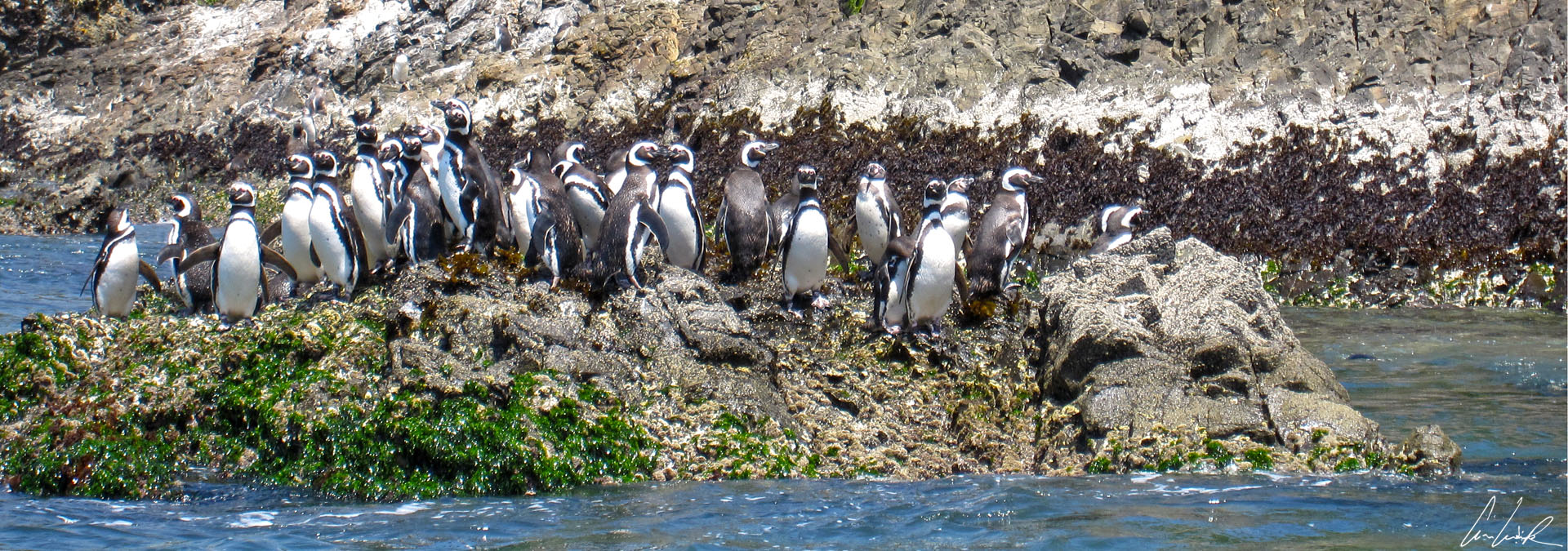
Monumento Natural Islotes de Puñihuil, the penguins
Change of scenery… we head to Puñihuil, a cove with a small fishing village on the northeastern coast of Isola Grande de Chiloé. Facing the community at the north tip of Puñihuil, three volcanic islets form the Islotes de Puñihuil Natural Monumento, a protected natural area established in 1999. This preserve is notable for being the only shared breeding site in Chile for Humboldt penguins (Spheniscus Humboldt) and Magellanic penguins (Spheniscus magellanicus) during the breeding season from mid-September to the end of March. Humboldt penguins are named after the cold current they swim in, which was in turn named after the explorer Alexander van Humboldt. Magellanic penguins named after the explorer Ferdinand Magellan. In English “penguin”, in Spanish “pingüino”, and in French Manchot, all three names refer to the southern hemisphere marine bird, as opposed to the penguin or Auks found in the northern hemisphere. Even if the physical resemblance exists, the two birds are completely different. The auks can fly and measure no more than 16 inches. The South Pole penguins or manchot are bigger and unable to fly because of their adaptation to marine life. They use their wings as fins… Crippled and armless, the bird was named “manchot” in French because of its clumsy gait! But when in the water, no more mockery, it is an excellent swimmer that reaches the speed of 12 mph and goes down to a depth of 260 feet ! Now, the tricky question… What distinguishes a Humboldt penguin (called “sùssa” by nomadic Indians) and a Magellanic penguin (baptized “sùrsa”)? Ha, ha, I do not want to hear the easy answer that one is black and white and the other white and black. Let me tell you a little about them. It is like a story of rival gangs ! The Humboldt penguins are identified by a black breast band that extends down their flanks to the thigh and by a slightly pink base of the bill. Magellanic penguins have a double black band between the head and the breast. The Humboldt penguin is also slightly smaller (22-28 in) than its cousin Magellan (24-30 in)… Will you be perceptive enough to find the two intruders that are hiding among the Magellanic penguins in the photo? And if you want to dive, either as a penguin or even deeper, into the atmosphere of these remote lands governed by Mother Nature at the end of the world, and hear the seagulls, the wind, the sound of the ocean and feel all the roughness of Patagonia, there is nothing better than reading the novel Tierra del Fuego by the Chilean writer Francisco Coloane. He has been called the Jack London of South America and was born on July 19, 1910, in Quemchi, on the island of Chiloé ! As for us, we take the ferry, heading back to the continent for the rest of the adventure, accompanied by a beautiful sunset !

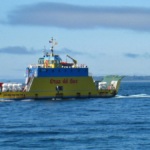




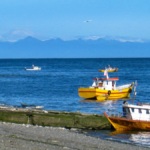
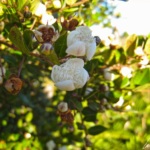
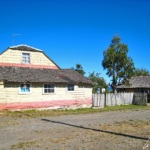
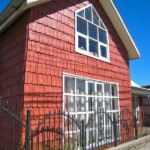
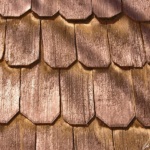
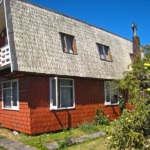
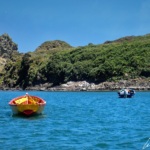
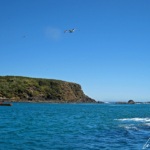
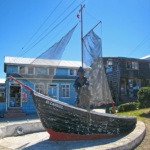
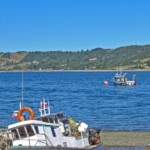
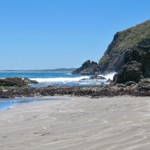
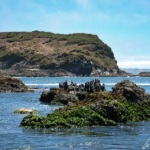

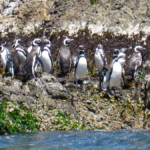
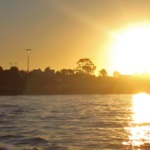


My family is from Uruguay and my dream is to hop over to Patagonia some day. Very inspiring post!
The Patagonia is so beautiful 🙂 Spaces are large, as are the silences that fill them !
It definitely seduces! The views, the architecture…I’d visit just to be amazed by the beauty around me!
It’s the people and the culture of the Chiloé which make it special 😉
Thanks for sharing this great town. I love the little penguins and the colorful fishing boats!!
The island of Chiloé really inspires us. It is worth to make a detour to this mystical sounding island: 15th century wooden churches now declared UNESCO world heritage sites, plus traditional fishing villages, untouched nature and a penguin colony, too 😉
I love the penguins! Gosh Chile has so much to offer. Such a diverse and beautiful country
Indeed, penguins are the cutest 😉 Chili is an amazing country ! Chiloé Island is just one of the places you could visit on your trip to Chile.
It looks like a step back in time – peaceful and beautiful. Being a fisherman’s town, the seafood there must be delicious!
The best way to learn about the way of life and local wisdom that makes this community so unique is from the people themselves, and the locals here will be more than willing to share some folklore tales with you 😉
I enjoyed reading the post! Thanks for sharing! The photos are beautiful!
Thank you 🙂 Chiloé gives a distinct flavor unique in South America 🙂
I haven’t been in this part of the world. A lovely island that deserves to be visited. I must put it on my bucket list. Thanks for sharing 🙂 Géraldine
Visiting Chiloé in Chile is like entering a magical realm – the inhabitants have a unique folklore and culinary traditions, while the island itself is a land of myths and legends 🙂
Wow such a wide and incredible range of natural wonders. I will definitely consider Chile for my future travels. The penguins are so cute!
Chile has no shortage of worthy destinations, but there’s one that increasingly captures the imagination of intrepid travelers: the island of Chiloé 😉
What a beautful place! My daughter would absolutely love to see the penguins in their natural habitat! How do you get there and is it kid friendly?
We took a small open boat to visit the colony of Magellanic and Humboldt penguins. The ride on a small boat is very entertaining and short so that children are not bored. The boat trips are well organised and compulsory wearing of life jackets is reassuring in fairly rough seas. Our guide went out of his way to point out different bird species, he made sure that everyone saw things.
This was a beautifully informative post about a gorgeous place. Love the photos!
Thank you 🙂 Chile is a paradise for nature lovers and outdoor enthusiasts !
You’re absolutely right. It does seduce. Love the charming shingled houses as well. Don’t know if I could live on an island with only a single paved road, but it looks like an incredible place to visit.
Visiting Chiloé is like entering a magical world blessed in nature and culture ! From the moment you first set foot on this extraordinary island, its singular identity will take you by surprise 😉